↑ ↓ ↑ ↓
RONALD L. BLOORE
NOT WITHOUT DESIGN
by Terrence Heath
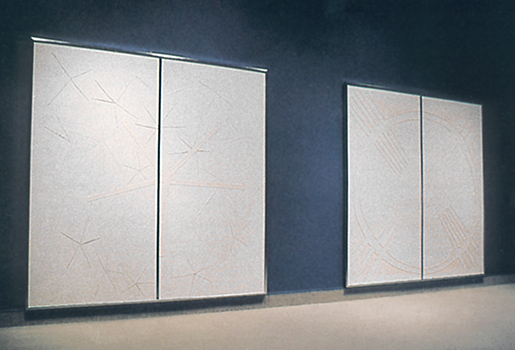
1988
No. 4
Peace Stars for Vince, donated to Casey House Hospice who recently
auctioned it away and 1988
No. 2
now at the Art Gallery of Hamilton
On these five pages is the entire english version of the curator's catalog essay. The show was organized by Andrew Oko of the MacKenzie Gallery in Regina in 1991 and travelled to Calgary, Edmonton, Hamilton and Halifax. Future pages will feature images of the shows. Interviews with five painters which took place at the Regina opening are here.
↑ ↓ ↑ ↓
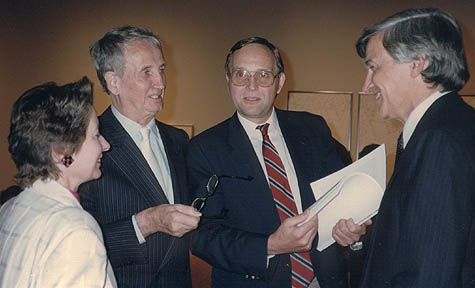
Illi Tamplin, RLB, Andrew Oko with catalog, Terrence Heath
All numbered footnotes from the original are preserved here and linked to the Notes and Quotes page. Heath's photo selection has been included also (and supplemented).
CH.2→ CH.3→ CH.4→
↑ ↓ ↑ ↓
Chapter One
FROM GRADUATE STUDENT
TO UNIVERSITY INSTRUCTOR
1949-1958

It may seem strange to argue that work done in graduate school at a relatively young age would determine the thinking of an artist/scholar for a lifetime, but, in the case of Ron Bloore, I think that is exactly what happened. The graduate school work becomes an almost invisible stream in the much richer and varied learning and thinking of his later years, but I will argue that certain tenets that are already evident in papers and interests of Bloore between 1949 and 1958 are basic to his later thinking. That the foundations of his thought were laid so early is an indication of both the thoroughness and seriousness of all his intellectual commitments and the passion with which he has pursued the implications of his thought over the ensuing decades. What some have seen as opinionatedness, even arrogance has been no more (or less) than this “high seriousness” in matters of visual art, its implications and societal dimensions.
↑ ↓ ↑ ↓

c. 1948, conté drawing
When Bloore arrived in New York in 1949 after four years of undergraduate work at the University of Toronto, he stepped into a world of contemporary art which was a startling contrast to that of Toronto. While Toronto still bathed in the aftermath of the nationalistic dreams of the Group of Seven and the disoriented social realism of the thirties, New York was a hotbed of contending aesthetic theories. The war years had brought large numbers of European artists and intellectuals to the city and the impact of their thought on the older traditions of American teachers, artists and museum curators thrust New York for the first time into the center stage of art developments in the western world. At the same time, the war brought the American economy to its feet and substantially crippled European competition. Serge Guilbaut argues that the economic changes and the dynamic and direction of American art were intimately linked. “The cultural history of the postwar period is the history of the reconstruction of American culture on new foundations laid by changes in the world economy in general and the American economy in particular.”(1)
As a desperately poor graduate student, Bloore did not participate in the American economic miracle and he was only a marginal observer in the dramatic happenings in the world of the city's contentious art politics. His time and thoughts were largely occupied with his graduate work and in particular with the painting of 17th century France. He was, however, already deeply interested in contemporary art, made the circuit of galleries and followed the controversies in the art news. The observations and impressions he made about the developments in contemporary art informed his studies in art history and archaeology. The intimate interplay in his thought between the past and the present became a lifetime touchstone of his art and teaching.
At a distance of forty years it is difficult to trace the specific shifts and changes in his intellectual formation, but a number of the more general and basic turns can be seen. Three critical nodes of thought which developed at this time are related to Bloore's later concepts of design, image and space. As will be seen, Bloore's understanding of these three concepts came to distinguish his work and thinking from the practices and ideas of Abstract Expressionism and the successive art movements which swept through much of the Canadian art world between 1955 and 1970.
In 1949, while he was studying in the graduate program at New York University, Ron Bloore wrote an essay which may have been his introduction to the Renaissance concept of disegno. It was certainly an intellectual encounter which was to be of significance in his later thinking and teaching. The subject of the essay was the prominent and influential 17th century theorist in the visual arts, Federico Zuccaro, whose major work was Idea de' Pittori, Scultori e Architetti (printed in 1607).
Disegno is what in the 1970's would have undoubtedly been called a seminal word in the study of the history of western art. Unfortunately, the English equivalent, design, does not capture either the intention or the scope of the original. Design in English has positive connotations, but now tends to be limited to the purely visual arrangement of colours, forms, functions or materials in some sort of utilitarian setting. We no longer use it much in speaking of drawing and painting. Dessin in French remains closer to the Italian.
In Renaissance Italy, disegno served a wide and exalted descriptive function. Disegno was an ordering of the elements of a painting in such a way that they reflected or re-created an ideal order. Indeed, later Mannerists, such as Zuccaro, could pun, in a medieval manner, on the derivation of disegno from di segno, that is, segno di Dio (blessing of God).(2) There is here more than a whiff of the lingering NeoPlatonism which characterized much of earlier Renaissance humanist thought. Belief in a divine order of creation, law, behaviour was nurtured by both classical and biblical sources and imbued all thought in a way we perhaps find phenomenologically incomprehensible today. In the intervening centuries, the word design in English or dessin in French has been limited or perhaps secularized in its meaning. (Although dessin still refers to the initial conception of a painting in the sketches and drawings of an artist.) The development of the word through the 19th century seems to have industrialized and democratized it in much the same way as genius and create. In any case, in the art world of today we are as unlikely to think of the Divine when we say design as when we say create.
Zuccaro cut a wide swath through the late Mannerist thinking of the 17th century, reviving mystical traditions and spelling out the first major challenge to the naturalist tendencies of earlier Renaissance thinkers. His thought can be seen most clearly by contrasting it with that of the early Renaissance artist and theorist, Leon Battista Alberti.(3) Alberti was the leading thinker of what Anthony Blunt called “the generation of 1420.” He espoused a world of thought informed by observation and science, perceptions structured by a mathematical/geometric paradigm. This world was for him normative for art: Perception, experience, mathematics and logic governed his thought.
A number of Mannerists reacted to the naturalism and mathematics of thinkers such as Alberti; Zuccaro, for example, asserted that the governing hand of art was not perception, but intellect or idea. As Anthony Blunt describes this belief, “The idea in the artist's mind was the source of all beauty in the works which he created, and his ability to give a picture of the outside world was of no importance, except in so far as it helped him to give visible expression to his idea.”(4) Zuccaro encapsulated this approach to art in the phrase "disegno interno," which is the reflection of the divine in the soul of the artist and the source of his ideas of truth, goodness and beauty.
In his art history course on Italian art, Bloore's essay on Zuccaro explored his thought and, in particular, his concept of disegno interno.(5) Much of the essay is, of course, given over to explicating Zuccaro's arguments, but Bloore parenthetically voices his unease with what he sees as the excessive theorizing of the Italian mannerist. He speculates that, even though the influence of art seems to increase in the late 16th and early 17th centuries, there may be a direct relationship between the decline of quality in Italian painting and this growth of theory. Bloore speculates: “...as the importance of art was raised, not through itself but by means of theory, the quality of that same art went down...”(6)
In passing, Bloore also records his reaction to the intense theoretical battles raging in New York at this time. Here, too, he thought he saw art making debilitated by art talk. Although he does not mention names, we need only think of the revolution in thinking in the arts which occurred in the United States during the Second World War and after: the rejection of Stalinism and the persistence of Trotskyism; social realism against abstract; the arguments about national and international art; between international and universal art; the strong voices of Schapiro, Greenberg, Rosenberg, Motherwell and Newman; the bitter attacks on “salon surrealism” and the rejection of European “decadence.” It is hard to gauge how cognizant a young graduate student was of the import or even existence of all these contending voices. Bloore, however, says, “He [Zuccaro] becomes extremely abstract in his speculation, too far removed from painting itself, like the majority of aesthetic concepts produced today.”(7) For Bloore, any discussion of art (and as a university lecturer he certainly did not avoid such discussions) must be firmly grounded in art making not in theory.
And, yet, there is a part of the thought of Zuccaro which Bloore, I believe, absorbed and made his own. Zuccaro rejected the extreme naturalism and the mathematic/geometric paradigm of the Renaissance, but his affirmation of disegno as an intellectual act encompassed an involvement in the surrounding world. Bloore quotes Zuccaro as saying: “For this art is assuredly not the daughter of mathematics, but of nature herself and of Design. The first shows it the form and the second teaches it to operate.”(8) It is instructive to look at the only statement Bloore is known to have made about his own art making in the light of this assertion. In 1961, he responded to a request for a statement: “My only intention while executing a painting is to make a preconceived image function formally as a painting.”(9) Here is the division of idea and design which seems to parallel Zuccaro.
↑ ↓ ↑ ↓
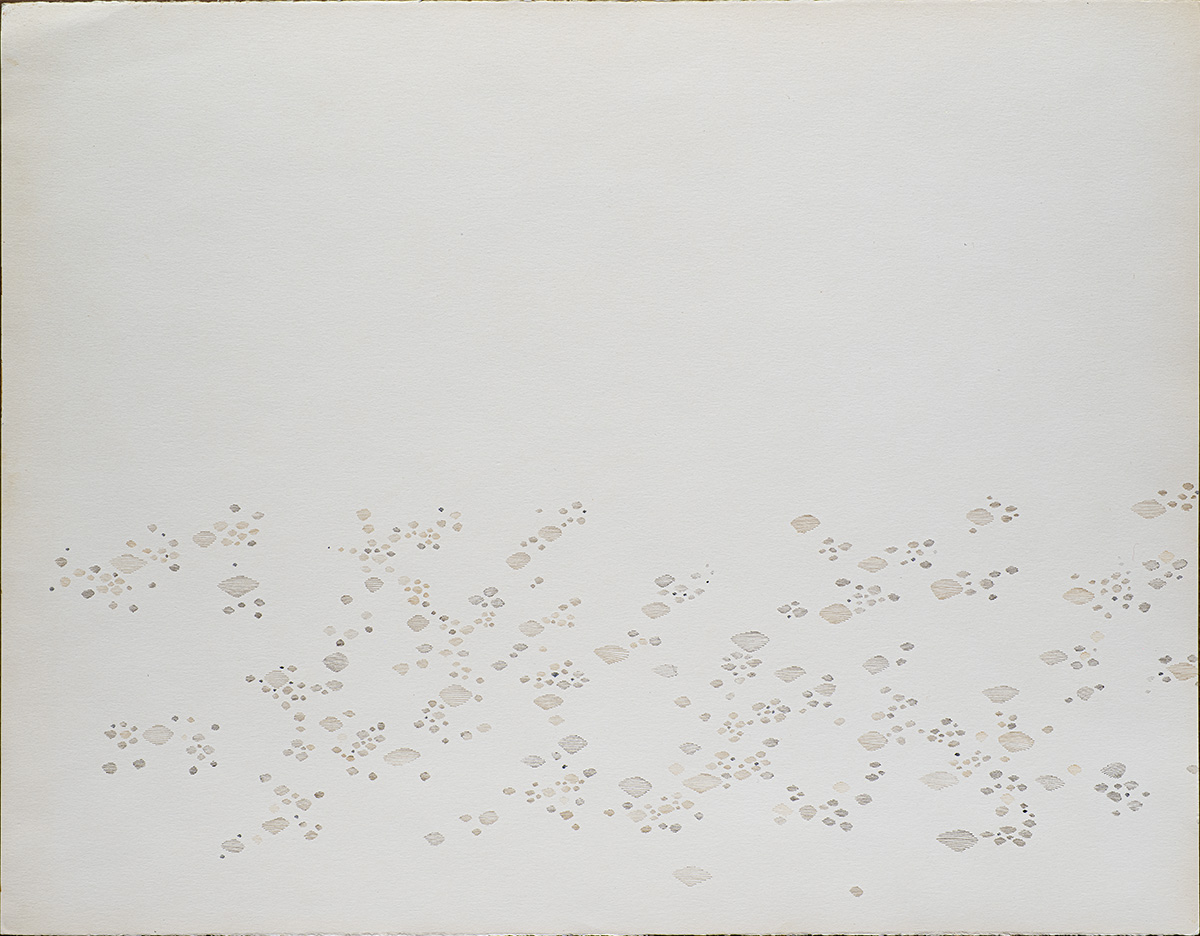
1960, Emma Lake, ink drawing on paper 52x66cm, click to view
much larger.
A similar drawing from 1960 done at Lac la Ronge is at the University of Toronto
another such drawing done at Emma Lake is at the Art Gallery of Peterborough.
It is also instructive to have the statement by Zuccaro in mind when looking at the small, exquisite drawings which Bloore did in 1960 at Lac la Ronge, Saskatchewan. In them we see, I think, the small pebbles in a stream, but they are not represented in a naturalistic way. Rather through a simple, variegated “shading” they are rendered not as primarily illusionistic objects but as design. Nature supplied the form and design taught it to operate. “Thus the painter,” Zuccaro goes on to say, “becomes competent, apart from the basic principles and teachings acquired from his predecessors or from nature herself, through the careful exercise of his innate judgment and the observance of the good and the beautiful without the further aid or the necessity of mathematics.”(10) That Bloore did these small drawings in the midst of a summer art camp, where the large scale paintings generated by the message of “big attack” coming from New York had created a euphoria for the big, was not, or at least not simply perversity;(11) Bloore has always had a firm grip on the central intellectual tenets of his art and he is unswayed by the enthusiasms of other artists, much less theorists.(12) On the one hand, for Bloore, scale has more to do with the issue of illusionistic space than with material size. On the other, he knew too much about the history of European painting and world art to see the recent American foray into large scale works as new or innovative.
Bloore's initial interest and primary field of study at graduate school was Chinese archaeology and art history, with a special focus on the development of Chinese bronzes. As it turned out, the period immediately after the 1948 revolution in China was not promising for field work or access to Chinese collections on the mainland. Bloore, therefore, turned to his second interest, French painting of the 17th century. The time and energy he devoted to studying Chinese art and history, however, left an indelible impression and a lifetime fascination with Oriental art. Some of this fascination can be seen in Bloore's work; some, in his thinking.
The impact of Oriental art, and especially Japanese printmaking, on European art is almost too extensive to trace. The flattening of colour, the layering of perspective and the crispness of outlines becomes an inseparable part of painting at the turn of the 20th century and a source of recurring orientation throughout the decades which follow. Much of this influence is, however, purely formal; it is a part of the story of an aesthetic revolution. Bloore's engagement with Oriental art has both a formal and a conceptual component.
Amongst Bloore's papers is a notebook in which he prepared his lectures on Chinese Archaeology for his first year of teaching at the University of Toronto.(13) These minute, cryptic, almost illegible notes yield a clue to an ongoing and basic intellectual concern. Here we find hundreds of small sketches tracing Chinese ideograms, hand gestures and the relation of these to natural objects. The lectures are for an introductory course and are not, therefore, meant as research material for anything other than didactic purposes. What we can see in them is Bloore's early interest in the relationship of calligraphy to painting. Painting begins with line; writing ends with image. There is an overlapping where text and painting are in fact one visual object. What is more, the training of the painter begins with calligraphic brushwork.
↑ ↓ ↑ ↓
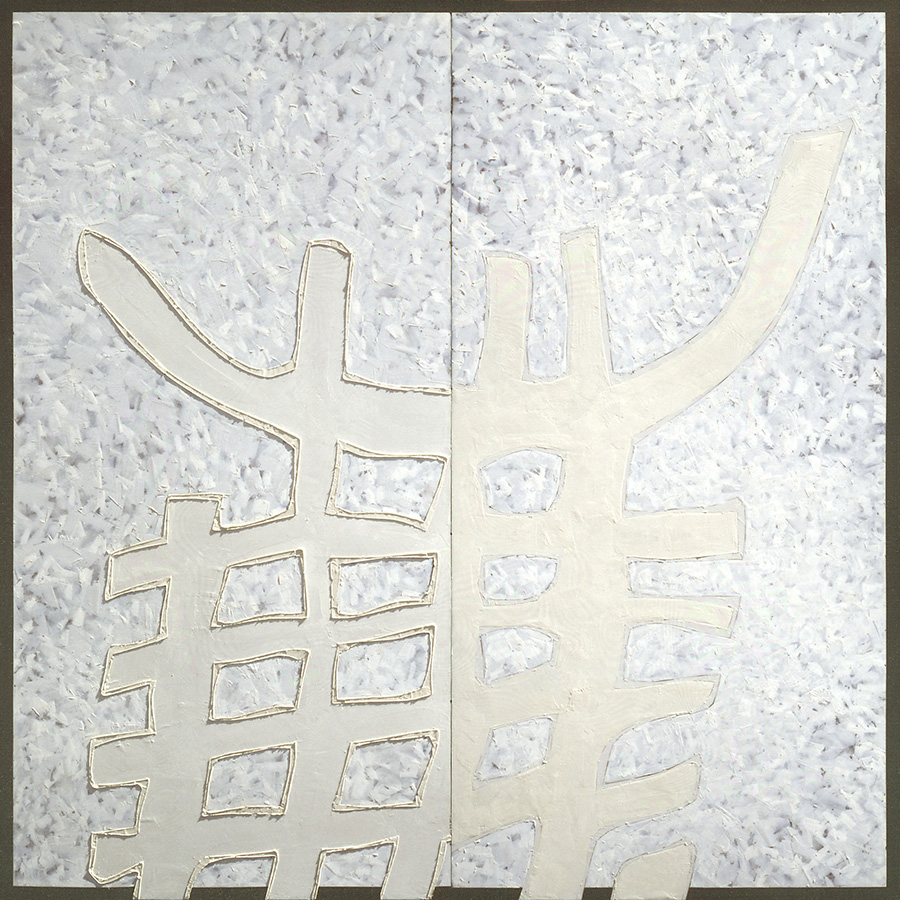
1989, Untitled IX, January 4-10, Catalog No.27, 244x244cm
McMaster University permanent collection, Hamilton, Ontario
In a lecture given in the academic year 1970-71, Bloore quotes from the 6th century Chinese master, Hsieh Ho, the six guidelines of the Chinese painter:
1) Circulation of the Ch'i produces life movement
2) Brush creates structure
3) According to the object, draw its form
4) According to the nature of the object, apply color
5) Organize composition with the elements in their proper places
6) In copying, pass on the essence of the master's brush and methods(14)
That is to say:
The visible world is full of the energy and vitality that we think of as life; the painter gives the structure, the line, the image. The subject matter is formed by this line, colour is added and the elements of the painting are organized. The whole is imbued with the accumulated tradition and knowledge of the great painters.
I think most people would say they see something of the Oriental in Bloore's paintings. The key to the “Oriental look” is the image defined by line on the surface plane and placed in a deep but undefined pictorial space. One of the basic differences that Bloore was to have later with the tenets of Greenberg was the focusing on colour as the essential basis of painting. Bloore sees the emphasis on colour and light in the work of the Impressionists as the final act of the overriding concern with the illusionism begun in the Renaissance, the culmination of art as pure perception. For Bloore, the beginning of the true revolution in western art history lies in the work and thought of Kandinsky and Mondrian.(15)
A third major source of Bloore's thinking was the small book by Wassily Kandinsky first published in 1926 and later translated as Point and Line to Plane.(16) He remembers having bought it at the Museum of Non-Objective Art shortly after he arrived in New York.(17) I think this work could be said to have given Bloore a way to “read” painting and sculpture without primary reference to representation. He discovered in Kandinsky's “new science of art” the elements of visual language - the phonemes and grammar of visual speech.
Kandinsky set out to examine the elements of art or, more particularly, painting in terms of point, line and plane. Point is the proto-element; line is point extended by movement in time and having tension and direction; plane is the two-dimensional surface area created by line. He continued to define in the same manner angles, circles, and modulations, examining psychological reaction, colour equivalencies and parallels in music as he proceeded. Kandinsky set the analysis of Point and Line to Plane in the larger context of his earlier, well-known work of 1912, The Spiritual in Art, but it is indicative of Bloore's specific interest in Kandinsky's formal thought that he has never read the latter work. In fact, it may be that Bloore even sees Kandinsky's spiritualism as a self-destructive element in his thought. He certainly has lamented the degradation of Kandinsky's thought “into a theory of emotive, therapeutic art.”(18)
Kandinsky's analysis is too complex to summarize easily, but a few examples may be selected to highlight parts of it which seem particularly relevant to Bloore's thinking. To begin at a general level, the lessons of Chinese painting with its origins in calligraphy and emphasis on line were bolstered by Kandinsky's placement of line and plane as the central concern of painting.(19) Kandinsky saw the rejection of line as “a confusion of nature and art.”(20) It is impossible to know how closely Bloore associated this statement with his own questioning of the primary role of colour in painting, but his argument that the Impressionist emphasis on colour and light signaled the end of the long Renaissance tradition of the central role of perception (and, therefore, the illusionistic representation of nature) parallels Kandinsky's argument that illusionism confuses nature and art whose end is the same but whose means are fundamentally different.(21)
At a detailed level, Kandinsky explored the inherent nature of the visual language. The simplest assertion, but one that permeates all of Kandinsky's subsequent inquiry, is that a point is rest; a line is movement. Further, a vertical line is different from a horizontal one. Psychologically, Kandinsky argues, the vertical line is warmth and height; the horizontal is characterized by coldness and flatness. They have “colour": the vertical line is white; the horizontal is black.(22) A square, then, is the most tranquil of planes in that it is a balance of warm vertical lines and cold horizontal lines.(23) The “basic plane” of a Josef Albers painting, for example, is neutral; the horizontal canvases of much of landscape painting are cold and earth-bound; the painting plane for a portrait is usually vertical, that is, warm and reaching upward. Not only do the lines creating a plane give the plane individual impacts, but the plane itself is a sort of aggregate of the lines which create it. Kandinsky schematizes these impacts as:
↑ ↓ ↑ ↓
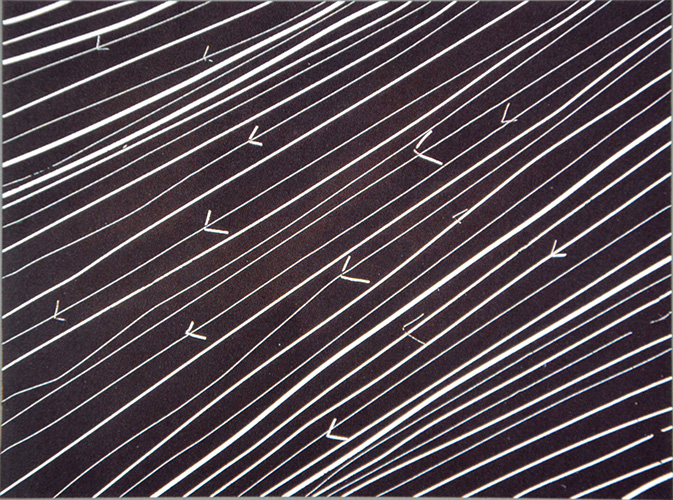
1983, September 26, Untitled, Catalog No.54, 56x76cm, ink on paper
Sequence (Tension) Literary
1. above: (toward) heaven
2. left: (into) the distance
3. right: (toward) home
4. below: (toward) the earth(24)
Much of this thinking is an extrapolation from subjective reactions and an attempt to find a ground in objective reality. Whether one agrees with them in detail, the overall intent is important. Bloore, I think, saw in this analysis an attempt to define what grammar and vocabulary of a visual language might be. In effect, Bloore (and Kandinsky) argues that we think outside of verbal signs and that this thinking is not simply an extension of representational imagery to signify inner realities, such as emotions or the unconscious. It is, in fact, a visual language.
After a lengthy discourse on how a circle is formed - through the widening of the angle, through the unequal pressures or tensions on a straight line, by angles from a point which radiate to equal lengths Kandinsky attempts to describe the “meaning” of a circle through metaphor. A circle is non-aggressive, the most unstable and the most stable of planes, complete and self-absorbed.(25) An interesting exercise is to take one of Kandinsky's extended metaphors on abstract forms, such as, “Something thoughtlessly youthful exists in the angle, while in the arc is a mature energy, rightfully self-conscious,”(26) and look at one of the series of paintings entitled Byzantine Lights which Bloore did in the early 1970s.
It may be possible to “read” Bloore's paintings with the Kandinsky dictionary/grammar in hand, but the real purpose of this analysis of form for Bloore was not to be able to break down a painting into component parts but rather to acquire a base for visual speech. Neither Bloore nor Kandinsky is a reductionist. They see art growing from simple “organisms” into complex beings. Kandinsky said, “Abstract art today is also creating primary, or more or less primary, art organisms, whose further development the present day painter can only surmise... Abstract art, which has gained its freedom, is also subject here to the 'laws of nature' and is forced to proceed as nature did formerly; from a modest beginning with protoplasm and cells, it very gradually advanced to more complex organisms.”(27) The need to begin at “ground zero” is, however, basic to both Kandinsky's and Bloore's thinking and, as we shall see, is a key to understanding Bloore's concept of himself as an artist in North America in the latter half of the 20th century.
The centrality of line is also the centrality of image. For Bloore, painting is primarily about image making, it is iconography. And, although the image may or may not be representational in the sense of signifying a perceived reality, it is nevertheless a meaningful sign in a visual language. The image is about content not about form for its own sake. Bloore is not interested in aesthetics as a way of defining art making.
Historically, the questioning, manipulation and rejection of Renaissance perspective (and its many offspring born of subsequent centuries of illusionistic painting) focused the attention of the 20th century painters radically onto the surface of the painting. From being transparent, “an open window,” as in Alberti, the surface became opaque and flat. Whether in colour field painting or geometric abstraction, the rejection of illusionism was the assertion of the primacy of surface as “real". In other words, the rejection of illusion tended to focus on the rejection of perspective and the illusion of space. The emphasis on line and image raises a particular problem in relation to the question of surface and illusion. In effect, as soon as a line is placed on the surface, an illusionary, pictorial space is created “behind” the line. The exhaustive use of grids in 20th century geometric painting can be seen as an attempt to deal with this problem by creating in the repetition of the canvas plane a “flatness that results from its [the grid's] coordinates.”(28) “Field” and “planarity” are two of the words which came to dominate the language of art critical theory.
The flatness of the surface of the canvas is, I think, a much easier thing to manipulate, perhaps even believe in, if you are a critic, using the verbal language, than if you are a painter, using the visual language. The experience of pictorial space is always present for the practitioner; it cannot be dismissed on semiotic grounds.
Recent evaluations of Abstract Expressionism emphasize this experience of space.(29) Edmund Burke's concept of the sublime and the work of Kant in The Critique of Judgement are used by commentators who have seen the expansive canvases of many Abstract Expressionists as an exploration of boundless and infinite space. Michael Auping suggests that “the most significant and ambitious contribution of postwar American art resides in an evolution in which form is subordinated to a monumental sense of space.”(30) In line with the emphasis on experience, Auping sees space itself as the subject matter of the painting, and it is this concern which extends itself far beyond Abstract Expressionism in the works of such artists as Dan Flavin, Richard Serra, Robert Irwin and Robert Smithson.(31) According to Auping, in the expanses of colour one sees the harbingers of the enveloping space as a total physical experience.
The experience of the sublime in the physical fields of colour is also, Auping argues, a confrontation with the phenomenon of self. The self is no longer the observing, distanced and thinking self, but the confronted, finite and existential self confronted with infinity. “The sublime in Newman's work or that of Rothko, Still, or Pollock is not an imagined space of raging seas or misty mountaintops but, rather, is a confrontation with self.”(32)
Bloore's thinking on the nature of pictorial space took a radically different turn from the thinking of the Abstract Expressionists discussed above. Beyond doubt, he respects the infinity of pictorial space, “artificial infinity,” as Burke called it.(33) It does not, however, have to do primarily with size and certainly not with colour. Whereas the image produced by point, line and plane may be flat, the space or field is deep and endless, no matter what size the painting is. I think he would agree with Lawrence Alloway when he critiques colour field painting: “...the term color field shows how the concept of all field was diminished [by American colour field painters]. Fields of what? Not possibility, not potential meaning, not unsorted phenomena, but of color... It is not a serious attempt to grapple with the implications of a special kind of spatial organization.”(34) Bloore sees background as infinite. In other words, the painted surface is flat at the image level because the image is always on the surface by its very nature of being a mark, but the background is another “surface,” perhaps in the way the sky is a visual dome and an infinite space. Behind the image is visual space, created not by canvas surface, but by the marks on the surface. It makes no sense to Bloore, for example, to stain canvas because the material surface of the painting is not visually a surface at all.
Similarly, for Bloore, the making of art is not the process of applying paint on the canvas surface; it is not the experience of painting, and, therefore, not a “personal” statement, much less an emotive act. It remains a carefully thought-out act of constructing or composing images. For Bloore, painting has to do, in the adopted language of semiotics, with an icon, not an index - that is, with the image, not with a direct physical relationship with the object; with symbol, not with trace.(35)
Each of these aspects of painting - design, image and space - is a building block to Bloore's later thought. They are together reference points for his own painting and the way in which he “reads” art history.